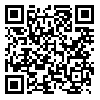Volume 15, Issue 2 (Vol.15, No.2 2019)
irje 2019, 15(2): 204-214 |
Back to browse issues page
Download citation:
BibTeX | RIS | EndNote | Medlars | ProCite | Reference Manager | RefWorks
Send citation to:



BibTeX | RIS | EndNote | Medlars | ProCite | Reference Manager | RefWorks
Send citation to:
Moradi G, Ghaderi E, Sargolzaei M, Fallahi H, Eybpoosh S, Tayeri K, et al . HIV/AIDS Surveillance System in the Islamic Republic of Iran: History, Structures and Processes. irje 2019; 15 (2) :204-214
URL: http://irje.tums.ac.ir/article-1-6349-en.html
URL: http://irje.tums.ac.ir/article-1-6349-en.html
GH Moradi1 
 , E Ghaderi1
, E Ghaderi1 
 , M Sargolzaei2
, M Sargolzaei2 
 , H Fallahi2
, H Fallahi2 
 , S Eybpoosh3
, S Eybpoosh3 
 , K Tayeri4
, K Tayeri4 
 , S Akbarpour5
, S Akbarpour5 
 , K Entezarmahdi6
, K Entezarmahdi6 
 , KH Rahmani *
, KH Rahmani * 
 7
7

 , E Ghaderi1
, E Ghaderi1 
 , M Sargolzaei2
, M Sargolzaei2 
 , H Fallahi2
, H Fallahi2 
 , S Eybpoosh3
, S Eybpoosh3 
 , K Tayeri4
, K Tayeri4 
 , S Akbarpour5
, S Akbarpour5 
 , K Entezarmahdi6
, K Entezarmahdi6 
 , KH Rahmani *
, KH Rahmani * 
 7
7
1- Associate Professor of Epidemiology, Social Determinants of Health Research Center, Research Institute for Health Development, Kurdistan University of Medical Sciences, Sanandaj, Iran
2- MD, Centre for Communicable Diseases Control, Ministry of Health and Medical Education, Tehran,
3- Assistance Professor of Epidemiology, Department of Epidemiology and Biostatistics, Research Centre for Emerging and Reemerging Infectious Diseases, Pasteur Institute of Iran, Tehran, Iran
4- Infectious diseases specialist, Iranian Research Center of HIV & AIDS, Tehran University of Medical Sciences, Tehran, Iran
5- PhD in Epidemiology, Centre for Communicable Diseases Control, Ministry of Health and Medical Education, Tehran, Iran
6- MSc student in Epidemiology, Social Determinants of Health Research Center, Research Institute for Health Development, Kurdistan University of Medical Sciences, Sanandaj, Iran
7- Assistant Professor of Epidemiology, Liver and Digestive Research Center, Research Institute for Health Development, Kurdistan University of Medical Sciences, Sanandaj, Iran
2- MD, Centre for Communicable Diseases Control, Ministry of Health and Medical Education, Tehran,
3- Assistance Professor of Epidemiology, Department of Epidemiology and Biostatistics, Research Centre for Emerging and Reemerging Infectious Diseases, Pasteur Institute of Iran, Tehran, Iran
4- Infectious diseases specialist, Iranian Research Center of HIV & AIDS, Tehran University of Medical Sciences, Tehran, Iran
5- PhD in Epidemiology, Centre for Communicable Diseases Control, Ministry of Health and Medical Education, Tehran, Iran
6- MSc student in Epidemiology, Social Determinants of Health Research Center, Research Institute for Health Development, Kurdistan University of Medical Sciences, Sanandaj, Iran
7- Assistant Professor of Epidemiology, Liver and Digestive Research Center, Research Institute for Health Development, Kurdistan University of Medical Sciences, Sanandaj, Iran
Abstract: (4547 Views)
Background and Objectives: Iran is one of the Middle Eastern countries that implemented the HIV / AIDS control and surveillance program many years ago. The purpose of this study was to review the HIV / AIDS surveillance system in Iran.
Methods: This was a review research to assess the processes, structures and achievements of the HIV/AIDS surveillance system in Iran. The information sources of this study included data from the surveillance system, reports and documentation, and published guidelines, reviewing existing structures and views of managers and practitioners of the HIV/AIDS surveillance system in Iran.
Results: In Iran, all cases with HIV / AIDS as well as people with high risk behaviors are referred to behavioral disease counseling centers in order to receive health care services. Harm reduction in people with risky behaviors in the form of counseling centers, drug addicts' centers, and women's counseling centers in collaboration with governmental and non-governmental organizations, and attention to the second generation of HIV/AIDS surveillance, particularly conducting behavioral studies, are other components of the HIV / AIDS surveillance system in Iran
Conclusion: Although the HIV / AIDS surveillance system in Iran has a large structure with many achievements in reducing new HIV cases, especially in some high-risk groups such as injecting drug users, as well as reducing HIV transmission from infected mothers to their children, strengthening this surveillance system, especially for sexual high-risk groups, is essential for controlling HIV/AIDS in the country.
Methods: This was a review research to assess the processes, structures and achievements of the HIV/AIDS surveillance system in Iran. The information sources of this study included data from the surveillance system, reports and documentation, and published guidelines, reviewing existing structures and views of managers and practitioners of the HIV/AIDS surveillance system in Iran.
Results: In Iran, all cases with HIV / AIDS as well as people with high risk behaviors are referred to behavioral disease counseling centers in order to receive health care services. Harm reduction in people with risky behaviors in the form of counseling centers, drug addicts' centers, and women's counseling centers in collaboration with governmental and non-governmental organizations, and attention to the second generation of HIV/AIDS surveillance, particularly conducting behavioral studies, are other components of the HIV / AIDS surveillance system in Iran
Conclusion: Although the HIV / AIDS surveillance system in Iran has a large structure with many achievements in reducing new HIV cases, especially in some high-risk groups such as injecting drug users, as well as reducing HIV transmission from infected mothers to their children, strengthening this surveillance system, especially for sexual high-risk groups, is essential for controlling HIV/AIDS in the country.
Type of Study: Research |
Subject:
General
Received: 2019/10/15 | Accepted: 2019/10/15 | Published: 2019/10/15
Received: 2019/10/15 | Accepted: 2019/10/15 | Published: 2019/10/15
| Rights and permissions | |
 |
This work is licensed under a Creative Commons Attribution-NonCommercial 4.0 International License. |



